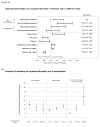Spironolactone and colitis: increased mortality in rodents and in humans
- PMID: 22081497
- PMCID: PMC3288762
- DOI: 10.1002/ibd.21929
Spironolactone and colitis: increased mortality in rodents and in humans
Abstract
Background: Crohn's disease causes intestinal inflammation leading to intestinal fibrosis. Spironolactone is an antifibrotic medication commonly used in heart failure to reduce mortality. We examined whether spironolactone is antifibrotic in the context of intestinal inflammation.
Methods: In vitro, spironolactone repressed fibrogenesis in transforming growth factor beta (TGF-β)-stimulated human colonic myofibroblasts. However, spironolactone therapy significantly increased mortality in two rodent models of inflammation-induced intestinal fibrosis, suggesting spironolactone could be harmful during intestinal inflammation. Since inflammatory bowel disease (IBD) patients rarely receive spironolactone therapy, we examined whether spironolactone use was associated with mortality in a common cause of inflammatory colitis, Clostridium difficile infection (CDI).
Results: Spironolactone use during CDI infection was associated with increased mortality in a retrospective cohort of 4008 inpatients (15.9% vs. 9.1%, n = 390 deaths, P < 0.0001). In patients without liver disease, the adjusted odds ratio (OR) for inpatient mortality associated with 80 mg spironolactone was 1.99 (95% confidence interval [CI]: 1.51-2.63) In contrast to the main effect of spironolactone mortality, multivariate modeling revealed a protective interaction between liver disease and spironolactone dose. The adjusted OR for mortality after CDI was 1.96 (95% CI: 1.50-2.55) for patients without liver disease on spironolactone vs. 1.28 (95% CI: 0.82-2.00) for patients with liver disease on spironolactone when compared to a reference group without liver disease or spironolactone use.
Conclusions: We propose that discontinuation of spironolactone in patients without liver disease during CDI could reduce hospital mortality by 2-fold, potentially reducing mortality from CDI by 35,000 patients annually across Europe and the U.S.
Copyright © 2011 Crohn's & Colitis Foundation of America, Inc.
Figures





Similar articles
-
Impact of superimposed Clostridium difficile infection in Crohn's or ulcerative colitis flares in the outpatient setting.Int J Colorectal Dis. 2018 Sep;33(9):1285-1294. doi: 10.1007/s00384-018-3105-8. Epub 2018 Jun 21. Int J Colorectal Dis. 2018. PMID: 29926235
-
Temporal trends in disease outcomes related to Clostridium difficile infection in patients with inflammatory bowel disease.Inflamm Bowel Dis. 2011 Apr;17(4):976-83. doi: 10.1002/ibd.21457. Epub 2010 Sep 7. Inflamm Bowel Dis. 2011. PMID: 20824818
-
The Impact of Clostridium difficile Infection on Mortality in Patients With Inflammatory Bowel Disease: A Systematic Review and Meta-Analysis.J Clin Gastroenterol. 2019 Feb;53(2):127-133. doi: 10.1097/MCG.0000000000000968. J Clin Gastroenterol. 2019. PMID: 29206751
-
Epidemiology of Clostridium difficile colitis in hospitalized patients with inflammatory bowel diseases.Dis Colon Rectum. 2009 Jan;52(1):40-5. doi: 10.1007/DCR.0b013e31819733fd. Dis Colon Rectum. 2009. PMID: 19273954
-
Impact of Clostridium difficile infection on inflammatory bowel disease outcome: a review.World J Gastroenterol. 2014 Sep 7;20(33):11736-42. doi: 10.3748/wjg.v20.i33.11736. World J Gastroenterol. 2014. PMID: 25206277 Free PMC article. Review.
Cited by
-
Effect of ABT-263 on Intestinal Fibrosis in Human Myofibroblasts, Human Intestinal Organoids, and the Mouse Salmonella typhimurium Model.Inflamm Bowel Dis. 2022 Feb 1;28(2):161-175. doi: 10.1093/ibd/izab166. Inflamm Bowel Dis. 2022. PMID: 34302470 Free PMC article.
-
Mineralocorticoid receptor activation contributes to intestinal fibrosis through neutrophil gelatinase-associated lipocalin in preclinical models.Nat Commun. 2025 Jul 9;16(1):6318. doi: 10.1038/s41467-025-61401-0. Nat Commun. 2025. PMID: 40634309 Free PMC article.
-
AXL Is a Potential Target for the Treatment of Intestinal Fibrosis.Inflamm Bowel Dis. 2021 Feb 16;27(3):303-316. doi: 10.1093/ibd/izaa169. Inflamm Bowel Dis. 2021. PMID: 32676663 Free PMC article.
-
Intestinal organoids: a model of intestinal fibrosis for evaluating anti-fibrotic drugs.Exp Mol Pathol. 2015 Jun;98(3):346-51. doi: 10.1016/j.yexmp.2015.03.033. Epub 2015 Mar 28. Exp Mol Pathol. 2015. PMID: 25828392 Free PMC article.
-
Novel Rho/MRTF/SRF inhibitors block matrix-stiffness and TGF-β-induced fibrogenesis in human colonic myofibroblasts.Inflamm Bowel Dis. 2014 Jan;20(1):154-65. doi: 10.1097/01.MIB.0000437615.98881.31. Inflamm Bowel Dis. 2014. PMID: 24280883 Free PMC article.
References
-
- Pitt B, Zannad F, Remme WJ, et al. The effect of spironolactone on morbidity and mortality in patients with severe heart failure. Randomized Aldactone Evaluation Study Investigators. N Engl J Med. 1999;341:709–717. - PubMed
-
- Tox U, Steffen HM. Impact of inhibitors of the Renin-Angiotensin-aldosterone system on liver fibrosis and portal hypertension. Curr Med Chem. 2006;13:3649–3661. - PubMed
-
- Mezzano SA, Ruiz-Ortega M, Egido J. Angiotensin II and renal fibrosis. Hypertension. 2001;38:635–638. - PubMed
-
- Rajagopalan S, Pitt B. Aldosterone as a target in congestive heart failure. Med Clin North Am. 2003;87:441–457. - PubMed
-
- Gullulu M, Akdag I, Kahvecioglu S, et al. Aldosterone blockage in proliferative glomerulonephritis prevents not only fibrosis, but proliferation as well. Ren Fail. 2006;28:509–514. - PubMed
